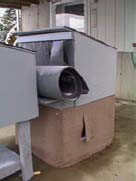I.
|
|
Complete design (conceptual, structural, material...) of a new feral cat feeding station
that will be distributed by MRFS to feral cat colonies. The structure will be presented in
the context of an art museum alongside research materials, documentation and mapping.
|
II.
|
|
Appropriation of existing feral cat feeding station design for miniature replicas that will be distributed by MRFS to volunteers of donors. The multiples would be presented in the context of an art museum alongside an original full-scale feral cat feeding station, research materials, documentation and mapping.
|
III.
|
|
TOO EXPENSIVE, OUT OF SCOPE, BUT FUN: Institute GPS tracking of cats belonging
to a specific colony and make data available to MRFS. Distribution of tracking devices
would be handled during spay/neuter weekend program. Real-time cat locations relative
to feeding stations will be projected in the context of an art museum alongside a full-scale
replica of an existing feral cat feeding station, research materials, documentation and
mapping. The projection of cat and shelter positions will be overlaid on an anonymous
blank map to ensure the security of the animals.
|
IV.
|
|
TOO EXPENSIVE, OUT OF SCOPE, BUT FUN: Institute physical sensor on flaps of feral
cat feeding stations. Transmit data (entries and exits) to internet gateway host. In an art
museum, a replica of the feeding station is equipped with Ethernet connectivity and a
robotic element that pushes or pulls the door flap when the cats enter or exit the real-world
feeding station. This would be presented alongside research materials, documentation
and mapping.
|
